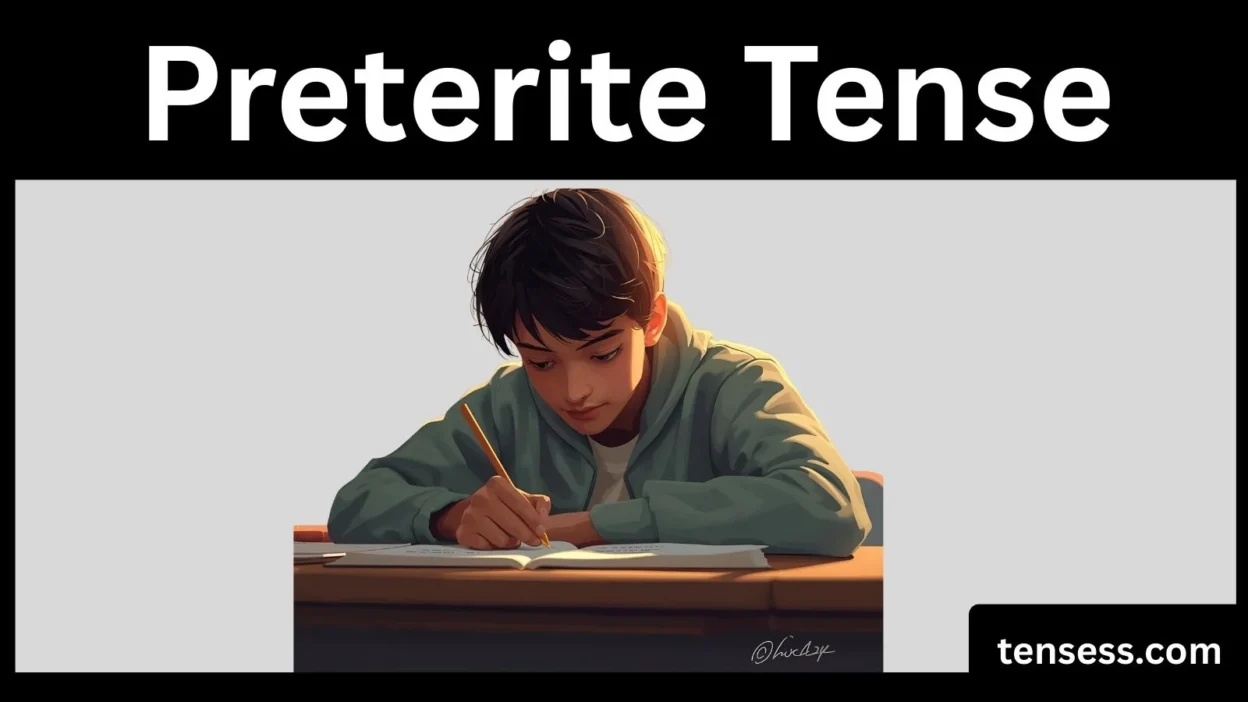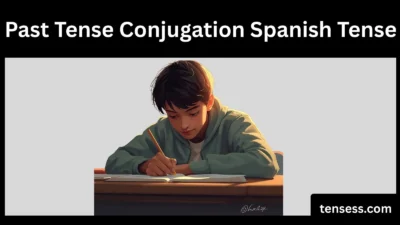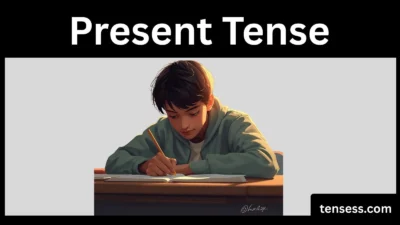The Spanish preterite tense is a cornerstone of Spanish grammar, essential for anyone learning the language.
if you’re a student, language enthusiast, or writer, mastering the preterite tense helps you describe completed actions in the past with precision.
This tense is used to talk about events that have a clear beginning and end, making it vital for storytelling, recounting events, or describing past experiences.
In this beginner-friendly guide, we’ll explore the definition, usage, and examples of the preterite tense, with clear explanations and real-life applications.
By the end, you’ll understand how to conjugate verbs, recognize patterns, and avoid common mistakes.
Let’s dive into the Spanish preterite tense and unlock its potential for your language journey!
What Is the Preterite Tense?
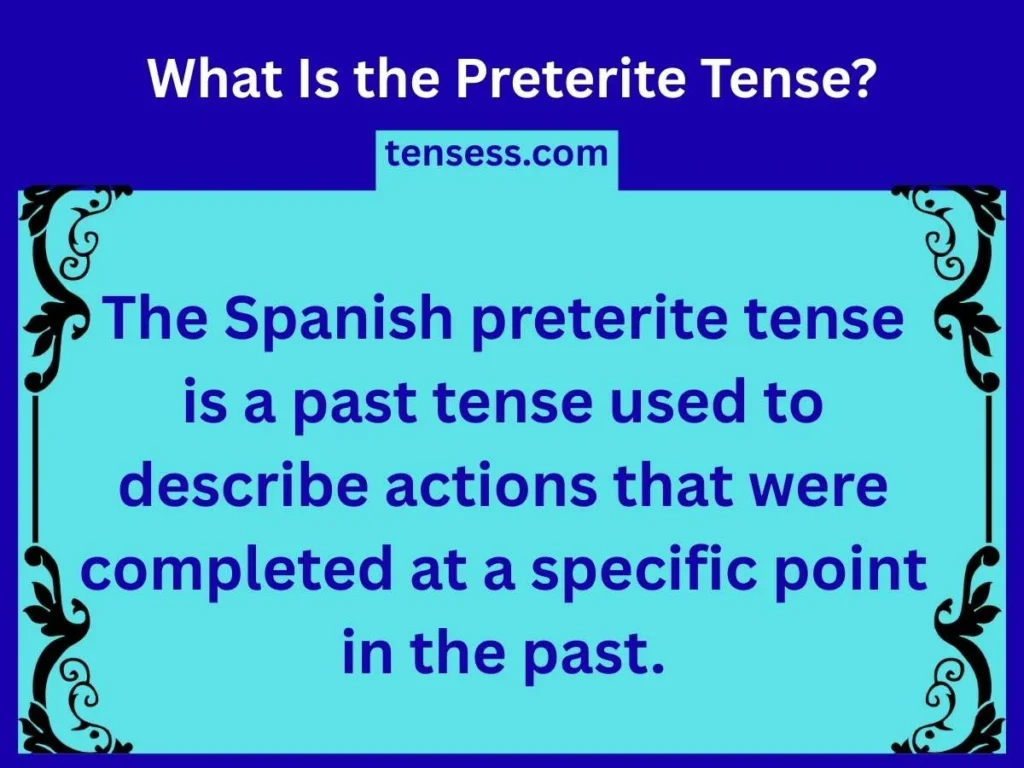
Unlike the imperfect tense, which describes ongoing or habitual actions, the preterite focuses on events that are finished. For example, “I read a book” in the preterite implies the reading is done.
Recognition of Preterite Tense
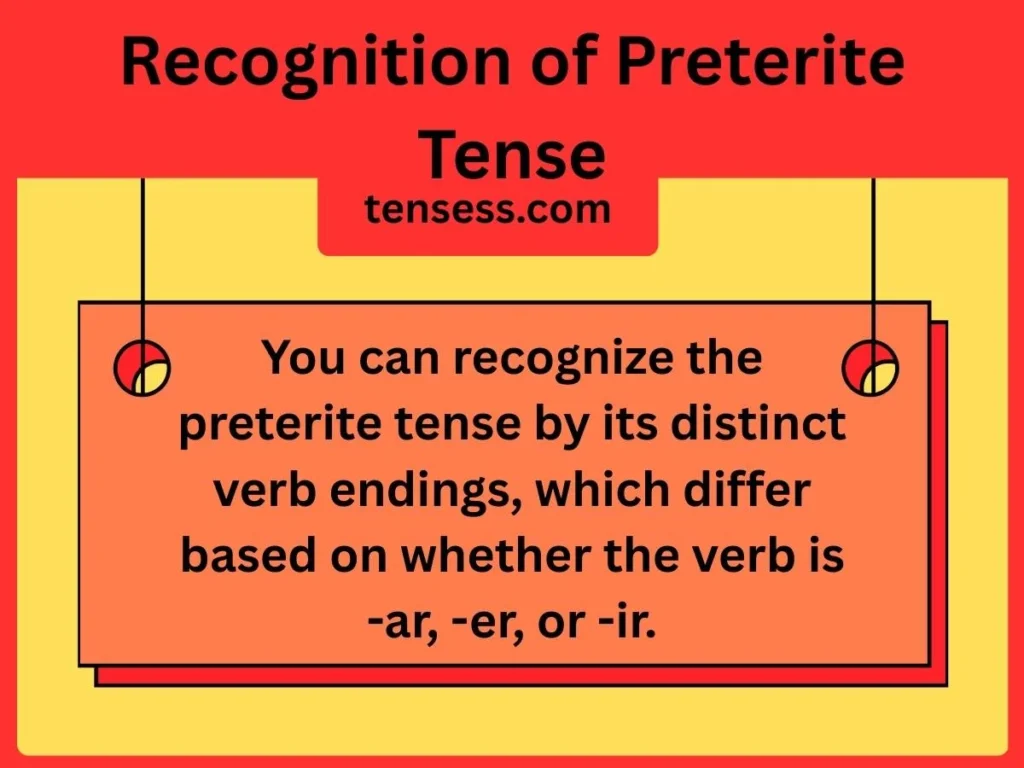
For instance, the verb “leer” (to read) in the preterite becomes “leí” for “I read.”
Structure of Sentence on Preterite Tense
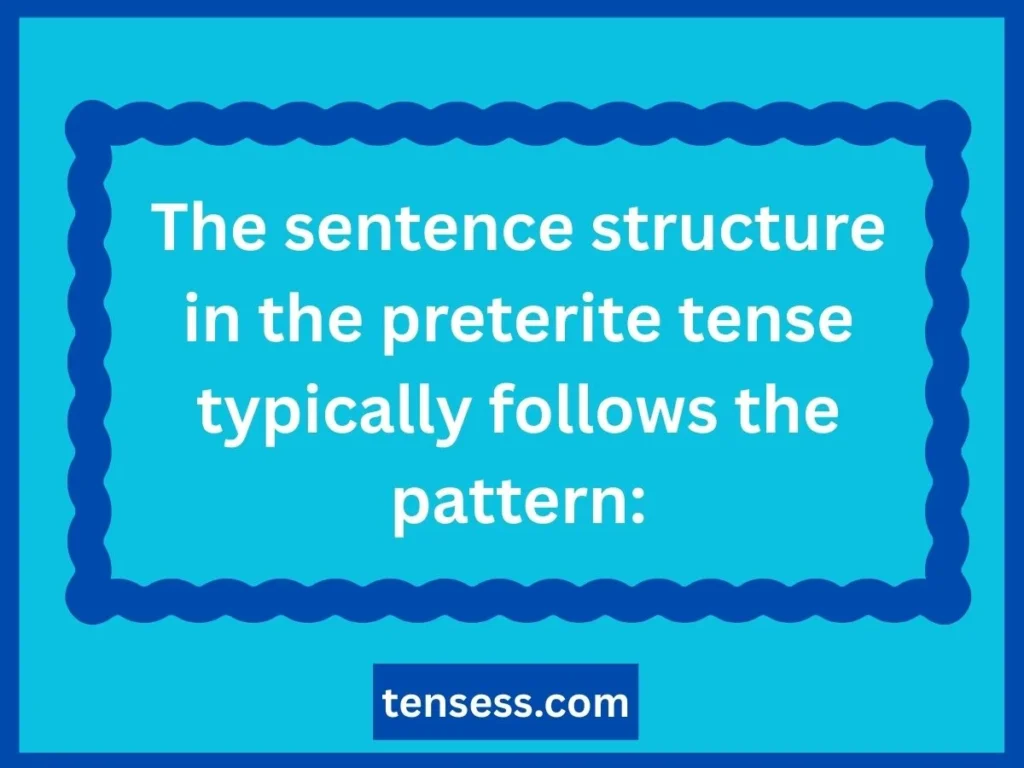
Subject + Conjugated Verb + Object/Complement. For example: “Ella comió pizza” (She ate pizza).
Formation of Preterite Tense
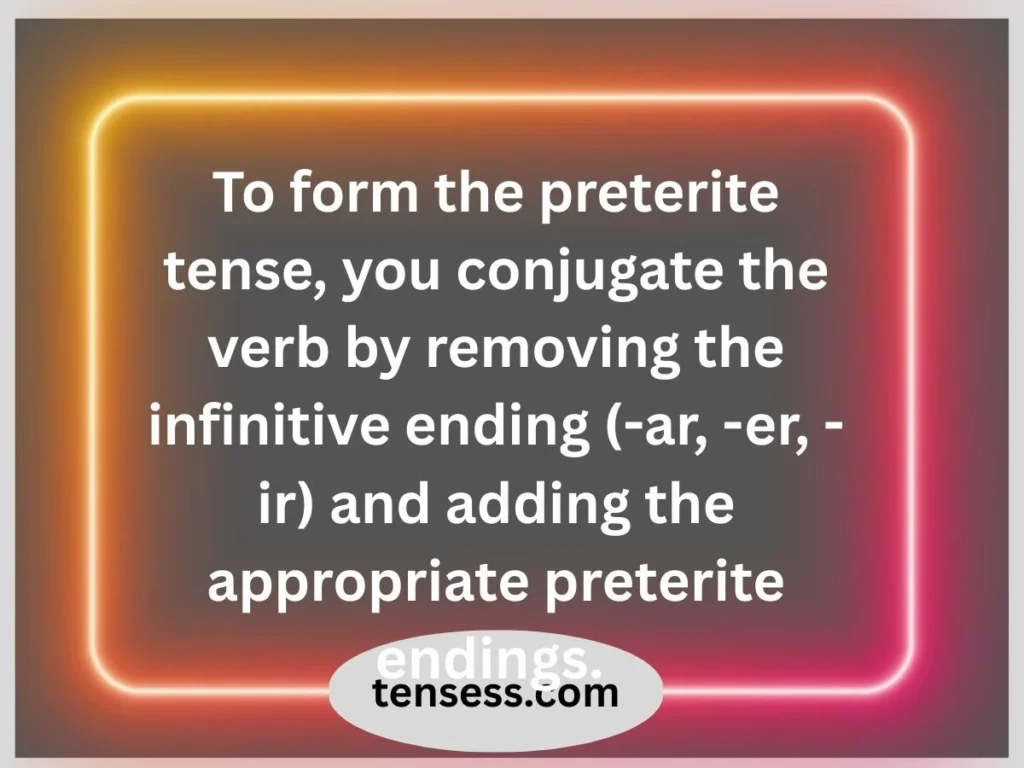
Regular verbs follow predictable patterns, while irregular verbs have unique conjugations.
Verbs
The preterite tense applies to both regular and irregular verbs. Common verbs like “hablar” (to speak), “comer” (to eat), and “vivir” (to live) are regular, while verbs like “ir” (to go) or “ser” (to be) are irregular.
Helping Verbs
The preterite tense does not typically use helping verbs like “haber” (used in perfect tenses). It stands alone to indicate a completed action.
Defining the Verb in the Preterite Tense
For the verb “leer” (to read), the preterite tense indicates a completed act of reading, such as “I read a book last night.” The focus is on the action’s completion.
Regular or Irregular
The verb “leer” is irregular in the preterite tense because its stem changes to “le-” and it uses unique endings for some subjects (e.g., “leíste” for “you read”).
10 Simple Sentence Examples
- Yo leí un libro. (I read a book.)
- Tú leíste una revista. (You read a magazine.)
- Él leyó un periódico. (He read a newspaper.)
- Nosotros leímos una novela. (We read a novel.)
- Vosotros leísteis un cuento. (You all read a story.)
- Ellos leyeron un artículo. (They read an article.)
- Ella leyó un poema. (She read a poem.)
- Usted leyó un ensayo. (You formal read an essay.)
- Juan y yo leímos un manual. (Juan and I read a manual.)
- Las chicas leyeron un blog. (The girls read a blog.)
How to Conjugate the Preterite Tense
Conjugating verbs in the Spanish preterite tense is straightforward for regular verbs but requires attention for irregular ones. Here’s a step-by-step guide:
- Identify the verb’s infinitive (e.g., hablar, comer, vivir).
- Remove the infinitive ending (-ar, -er, -ir).
- Add the appropriate preterite endings based on the verb type.
- For -ar verbs, use endings: -é, -aste, -ó, -amos, -asteis, -aron.
- For -er and -ir verbs, use endings: -í, -iste, -ió, -imos, -isteis, -ieron.
- For irregular verbs, memorize unique stems and endings (e.g., “tener” becomes “tuve”).
- Check for stem changes in certain irregular verbs (e.g., “leer” to “le-“).
- Pay attention to spelling changes, like “car” to “qué” in “buscar” (busqué).
- Practice with common verbs to build confidence.
- Use conjugation charts for reference.
Conjugation Table for “Leer”
| Subject | Conjugation |
| Yo | leí |
| Tú | leíste |
| Él/Ella/Usted | leyó |
| Nosotros | leímos |
| Vosotros | leísteis |
| Ellos/Ellas/Ustedes | leyeron |
Spelling Changes or Irregularities
The verb “leer” is irregular in the preterite tense. Its stem changes to “le-” or “ley-” depending on the subject, and the third-person plural ending includes a “y” (leyeron) to maintain pronunciation.
Examples of Preterite Tense Sentences
Here are 10 diverse examples of the preterite tense with different subjects:
- Yo comí una manzana ayer. (I ate an apple yesterday.)
- Tú hablaste con María. (You spoke with María.)
- Él vivió en México por un año. (He lived in Mexico for a year.)
- Ella cantó en el concierto. (She sang at the concert.)
- Nosotros fuimos al cine. (We went to the cinema.)
- Vosotros bebisteis agua. (You all drank water.)
- Ellos trabajaron toda la mañana. (They worked all morning.)
- Usted compró un coche nuevo. (You formal bought a new car.)
- Las niñas jugaron en el parque. (The girls played in the park.)
- Juan escribió una carta. (Juan wrote a letter.)
Common Mistakes with the Preterite Tense
- Confusing preterite with imperfect: Use preterite for completed actions, not ongoing ones (e.g., “I ate” vs. “I was eating”).
- Incorrect endings: Using -er endings on -ar verbs (e.g., “hablí” instead of “hablé”).
- Forgetting irregular conjugations: Verbs like “ir” (fui) don’t follow regular patterns.
- Misusing stem changes: Applying stem changes to regular verbs (e.g., “comí” is correct, not “comé”).
- Spelling errors: Missing the “y” in verbs like “leer” (leyeron, not leieron).
- Overusing the preterite: Not every past action needs the preterite; check context.
- Ignoring accents: Accents matter (e.g., “hablé” vs. “hable”).
- Subject-verb agreement errors: Ensure the ending matches the subject (e.g., “tú hablaste,” not “tú habló”).
- Using helping verbs: The preterite doesn’t need “haber” or other auxiliaries.
- Misplacing time markers: Use words like “ayer” to clarify the preterite’s timeframe.
Related Verbs and Synonyms for the Preterite Tense
The preterite tense applies to many verbs, but some are often confused:
- Ser (to be): Preterite “fui” for specific events.
- Estar (to be): Preterite “estuve” for temporary states.
- Ir (to go): Preterite “fui” shares forms with “ser.”
- Tener (to have): Preterite “tuve” for possession.
- Hacer (to do/make): Preterite “hice” for completed actions.
- Decir (to say): Preterite “dije” for specific statements.
- Ver (to see): Preterite “vi” for specific sights.
- Saber (to know): Preterite “supe” for learning something.
- Querer (to want): Preterite “quise” for specific desires.
- Poder (to be able): Preterite “pude” for completed abilities.
Comparison Example:
- Ser: “Fui estudiante” (I was a student, permanent).
- Estar: “Estuve cansado” (I was tired, temporary).
Tips to Practice Using the Preterite Tense
- Practice with flashcards for regular and irregular conjugations.
- Write a short story using only the preterite tense.
- Use apps like Duolingo for interactive exercises.
- Conjugate 10 verbs daily in the preterite.
- Speak with native speakers to practice real-life usage.
- Create sentences with time markers (e.g., “ayer,” “anoche”).
- Listen to Spanish podcasts for context clues.
- Review irregular verb lists regularly.
- Pair preterite verbs with specific past events.
- Join language forums to discuss verb usage.
Frequently Asked Questions
- What’s the difference between preterite and imperfect? Preterite is for completed actions; imperfect is for ongoing or habitual ones.
- Are all verbs regular in the preterite? No, many common verbs like “ir” and “ser” are irregular.
- How do I know when to use the preterite? Use it for actions with a clear start and end.
- What are common preterite time markers? Words like “ayer,” “anoche,” or “la semana pasada.”
- Do accents matter in the preterite? Yes, they affect meaning and pronunciation.
- Can I use helping verbs in the preterite? No, the preterite is standalone.
- Why is “leer” irregular? Its stem changes to maintain pronunciation.
- How do I memorize irregular verbs? Use mnemonic devices or practice regularly.
- Is the preterite used in writing only? No, it’s common in speaking too.
- Where can I practice the preterite? Try online quizzes or language apps.
Exercises
- Conjugate “hablar” in the preterite for all subjects.
- Write 5 sentences using “comer” in the preterite.
- Identify the tense in: “Ella cantó ayer.”
- Correct: “Yo comí una pizza anoche.”
- Translate: “We read a book last week.”
- Conjugate “ir” in the preterite for “tú” and “ellos.”
- Write a sentence with “vivir” in the preterite.
- Fill in: “Nosotros ___ (beber) agua.”
- Create a dialogue using 3 preterite verbs.
- List 5 irregular preterite verbs.
Quizzes
- What is the preterite of “yo” for “leer”? (Answer: leí)
- True/False: The preterite needs a helping verb. (False)
- What’s the preterite of “tú” for “comer”? (Answer: comiste)
- Choose: “Ella ___ (cantar) anoche.” (Answer: cantó)
- Translate: “They went to the park.” (Answer: Fueron al parque.)
- What’s the preterite of “nosotros” for “vivir”? (Answer: vivimos)
- Correct or incorrect: “Yo hablí ayer.” (Incorrect: hablé)
- What’s the preterite of “ellos” for “hacer”? (Answer: hicieron)
- Identify the irregular verb: hablar, comer, ser. (Answer: ser)
- Fill in: “Tú ___ (decir) la verdad.” (Answer: dijiste)
Conclusion
Mastering the Spanish preterite tense opens doors to confident communication in Spanish.
By understanding its definition, conjugation, and usage, you can describe past events with clarity and accuracy.
From regular verbs like “hablar” to irregular ones like “leer,” this tense is key for storytelling and everyday conversations.
Practice with the provided exercises and quizzes, and avoid common mistakes by focusing on context and verb forms.
Keep exploring with real-life examples, and don’t hesitate to use tools like grammar checkers or language apps to refine your skills.
Start writing your own preterite tense sentences today, and share your progress in the comments below or on language forums!
